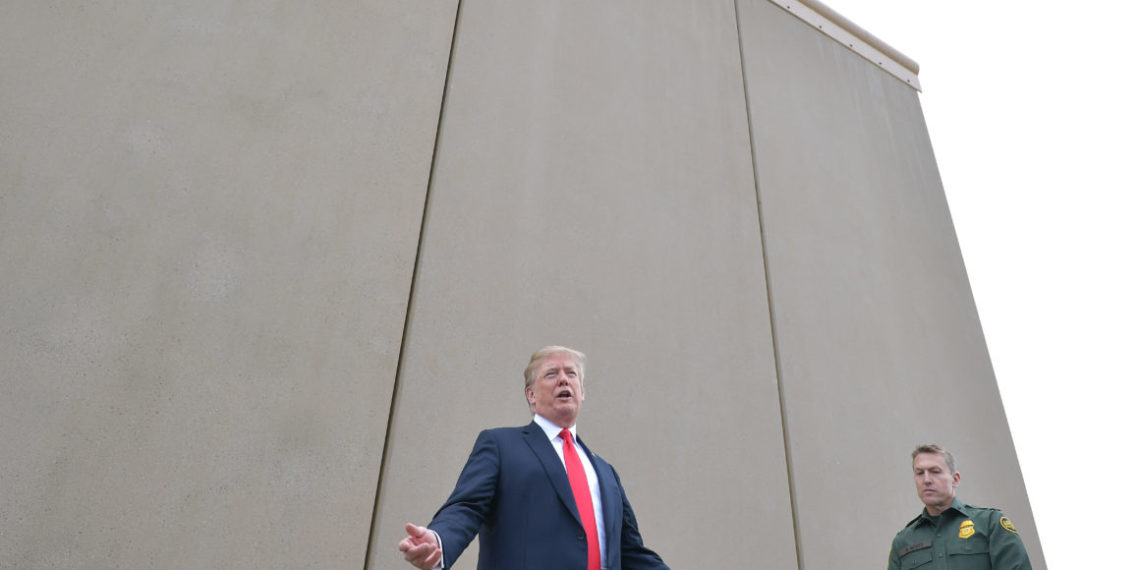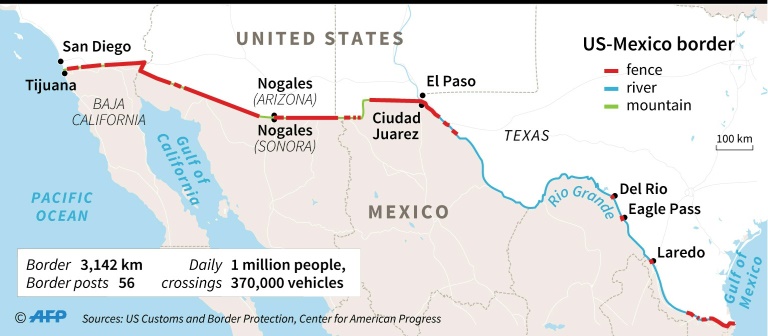President Donald J. Trump’s latest effort to divert attention from his and his team’s legal problems involves a game of chicken with Democrats in Congress over funding for his southwestern border wall. He demands $5 billion as a “down payment” on the wall or else he will shut down much of the federal government.
While the White House has begun backpedaling on the shutdown threat, Trump is certain to continue pushing Congress to fund his cherished border wall, one way or another.
Border security has been a political football for leaders of both of our major parties – and some independent candidates – for decades.
President Trump recently acknowledged that most of his wall has already been built. But not on his watch. Aside from a few relatively minor projects to repair or replace existing fencing, what he calls “the wall” has been built piecemeal, by a steady succession of presidents and Congresses since 1994. It actually began as a Democratic project, intended to insulate President Bill Clinton from rising anti-immigrant sentiment in the run-up to his 1996 reelection campaign.
What we have created over this quarter-century is a formidable obstacle course for would-be undocumented migrants. It consists of stadium-intensity lighting, highly advanced radar systems, thermal imaging, high-definition cameras, and double (in some places triple) fencing in all urban areas. The barriers stretch out eastward into the California and Arizona deserts and westward into the Pacific Ocean.
Roughly one-third of the U.S. border with Mexico has either vehicle or pedestrian barriers in place. There are practical reasons why the remaining stretches of the border haven’t been fortified. These are areas with natural barriers that make it virtually impossible to build on, like highly irregular topography, streams or rivers that flow across the border, wildlife reserves, and Indian reservations. Pouring concrete from sea to shining sea is simply not an option.
Trump’s concept of his border wall has shape-shifted frequently. During his presidential campaign, he made it seem like he wanted a continuous, 1,000-mile, solid concrete wall. Later it became a hodge-podge of existing fencing, new barriers built to his specs, and electronic surveillance. It’s hard to tell what he wants now, except that he expects Congress to appropriate billions more for some type of border security.
Price Tag of Trump’s Border Wall
The price tag for Trump’s original concept is estimated at $25 billion on the low end to $70 billion at the top. Plus, at least a half-billion each year for maintenance.
A significant chunk of the cost involves acquiring the land for the project, most of which is privately owned by ranchers. Even if the federal government seizes it through the legal mechanism of eminent domain, the inevitable litigation will consume thousands of hours of government lawyers’ time.
What has been accomplished by the border enforcement build-up to date?
It hasn’t kept determined migrants out of the country.
Tens of thousands of field interviews have shown that more than 90 percent of undocumented migrants who try to enter the U.S. eventually succeed. This large body of empirical evidence, produced by my field research program at UC San Diego and two others at Princeton University and the University of Texas-El Paso, shows that continued construction of physical barriers at the border will not appreciably deter people desperately trying to escape low-end poverty and violence in their hometowns.
Migrants and the people smugglers who assist them will go around, climb over, or dig under any kind of fencing. Even 18-foot-tall steel barriers can be scaled in less than a minute by a reasonably fit person, often using ladders provided by people smugglers. At most, physical pedestrian barriers slow down would-be unauthorized migrants. Vehicle barriers, consisting of short posts, don’t even do that.
Unintended Consequences
Nevertheless, the existing obstacle course at the border has accomplished three things – all unintended consequences.
First, we have greatly enriched the people smuggling industry, which can charge more for its services because we have made the border less porous. Second, border fortification has sharply increased the probability that migrants who make it into the United States will settle there permanently. Finally, we have diverted much of the flow of unauthorized migrants from remote areas into the legal ports of entry, where between one-third and one-half of all crossings by undocumented migrants now occur, according to field interviews. People smugglers get them through the ports by providing false documents or concealing them in vehicles.
There is no reason to believe that Trump’s wall – if it were ever to be built – would have different outcomes.
But Democrats always fear being labeled as soft on border security. They have, in fact, supported border security legislation over the years. These measures cost taxpayers tens of billions of dollars, mostly for a greatly expanded Border Patrol and enhanced electronic surveillance technologies.
Anytime you hear a Democrat saying that you can have good Border Security without a Wall, write them off as just another politician following the party line. Time for us to save billions of dollars a year and have, at the same time, far greater safety and control!
— Donald J. Trump (@realDonaldTrump) December 17, 2018
Trump knows this, even as he derides Democrats as “open borders” advocates. If the funds demanded by Trump can be portrayed as only for border housekeeping – repairing or replacing existing segments of fencing, rather than earmarked for construction of a wrong-headed Trump wall – Democrats would probably go along.
Such a response would make a mockery of House Minority Leader Nancy Pelosi’s recent call for an “evidence-based discussion” of border issues. The overwhelming weight of evidence clearly argues against more-of-the-same investment in border enforcement, which would have more-of-the-same unintended consequences.
But, more often than not, U.S. immigration policy-making has been impervious to scientific evidence. That gives Trump an opening. Democrats may eventually help him cobble together a new pot of $5 billion for “border security,” even if none of it can be spent on building a new wall.
Disclaimer: The views and opinions expressed here are those of the author and do not necessarily reflect the editorial position of The Globe Post.





















